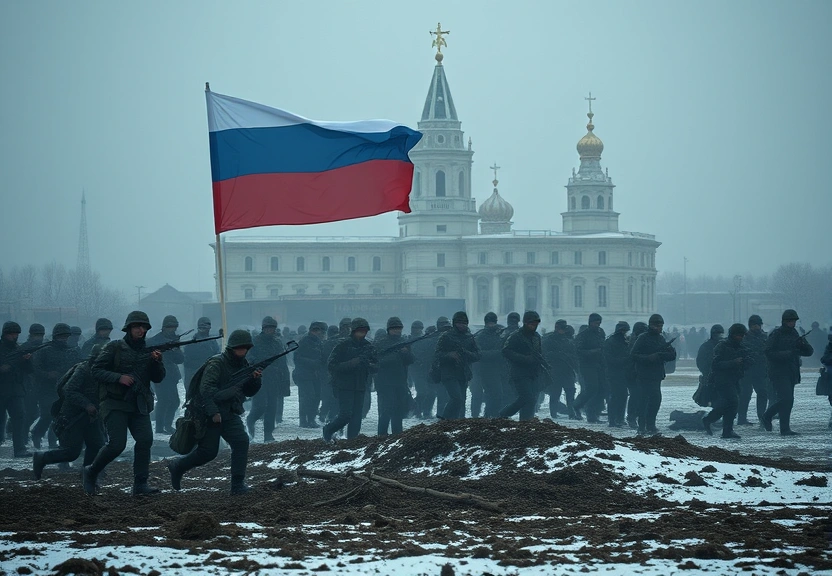Russia Nears 1 Million War Casualties in Ukraine, Study Finds
As the conflict in Ukraine enters its third year, recent studies reveal a staggering human cost associated with Russia’s full-scale invasion. Nearly 1 million Russian soldiers have reportedly been killed or injured since the onset of this unprovoked assault by President Vladimir Putin. This figure not only highlights the devastating impact of the war on Russia’s military but also raises critical questions about the long-term implications for both Russia and Ukraine.

The war, which began in February 2022, has escalated into one of the most significant military conflicts in modern history. With such high casualty rates, it is essential to examine the factors contributing to these losses, the implications for Russian military strategy, and the broader ramifications for international relations. This article will delve into these aspects while providing a comprehensive overview of the current situation in Ukraine and its impact on Russia.
The Human Cost of the Invasion
Understanding the human cost of the war is crucial in grasping the full scope of the conflict. According to the latest reports, the casualty figures encompass both dead and injured soldiers, reflecting a significant toll on Russia’s military capacity. The study that brought these figures to light underscores the grim reality of war, particularly for a nation like Russia that has historically had a vast military presence.
The Toll on Russian Military Forces
The sheer number of casualties raises questions about the effectiveness of Russia’s military strategy and the sustainability of its operations in Ukraine. High casualty rates can severely impact troop morale, operational capabilities, and the overall effectiveness of military campaigns. As more soldiers are lost or incapacitated, the Russian military may struggle to maintain sufficient forces to achieve its objectives.
Broader Implications for Russia
The implications of such high casualty rates extend beyond the battlefield. Public perception of the war in Russia is likely to shift as families receive news of their loved ones’ injuries or deaths. This could lead to increased dissent against the government and calls for an end to the conflict. Moreover, the casualties may strain Russia’s economic resources, forcing the government to reallocate funds from other critical areas such as healthcare and education to support the war effort.
Comparing Casualties: Russia vs. Ukraine
A clear understanding of the casualty figures on both sides is essential for contextualizing the war. While Russia has experienced nearly 1 million casualties, Ukraine has also faced significant losses. Various reports indicate that Ukrainian forces have suffered comparable, if not greater, numbers of casualties. This raises critical questions about the war’s sustainability for both nations and the potential for a negotiated settlement.
Challenges Faced by Ukraine
Ukraine’s resistance has been marked by fierce fighting and resilience. However, the human cost is profound, with countless lives lost and many more injured. The continuous influx of casualties inevitably affects the morale of both soldiers and civilians. Yet, Ukrainian forces have displayed remarkable tenacity, often aided by international support, which has bolstered their operational capabilities.
International Response and Military Aid
The international community’s response to the war has also played a significant role in shaping the conflict. Countries worldwide have provided military and humanitarian assistance to Ukraine, further complicating the dynamics of the war. The support received by Ukraine stands in stark contrast to the challenges faced by Russia, which has increasingly isolated itself from much of the global community due to its actions in Ukraine.
Future Prospects: What Lies Ahead?
As the conflict continues, the future remains uncertain. The nearly 1 million war casualties reported for Russia could have far-reaching effects on military strategy, domestic politics, and international relations. The loss of a significant portion of military personnel may compel Russian leadership to reconsider its approach to the conflict, potentially leading to negotiations or a change in tactics.
Possibilities for Negotiations
With both sides facing high casualty rates, there is a growing call for negotiations to resolve the conflict. International mediators may play a critical role in facilitating discussions that could lead to a ceasefire or a more permanent resolution. However, as long as both nations remain committed to their objectives, the prospect of peace may remain elusive.
The Role of Public Perception
Public perception will also play a pivotal role in shaping the future of the conflict. As casualties mount, citizens in both Russia and Ukraine are likely to voice their opinions regarding the war. In Russia, increased casualties may lead to public outcry against the government, while in Ukraine, continued resistance may strengthen national unity against the aggressor. Understanding and addressing public sentiment could be key to any future peace negotiations.
Key Points of the Conflict
- Nearly 1 million Russian soldiers have been killed or injured since the invasion began.
- The high casualty rate raises concerns about the sustainability of Russian military operations.
- Ukraine has also suffered significant casualties, impacting its military and civilian populations.
- International military support for Ukraine complicates the war dynamics and affects Russian strategy.
- Public perception and political pressure in both countries could influence the future of the conflict.
Frequently Asked Questions (FAQs)
1. What is the main cause of the high casualty rates in the Russia-Ukraine war?
The high casualty rates can be attributed to intense fighting, strategic errors, and the scale of military operations. Both sides have engaged in significant combat, which has led to substantial losses.
2. How has the conflict affected Russian society?
The conflict has led to rising public dissatisfaction within Russia, as families cope with the loss or injury of loved ones. This could potentially lead to increased dissent against the government.
3. What role does international support play in the conflict?
International support has been crucial for Ukraine, providing military resources and humanitarian aid. This assistance has bolstered Ukraine’s ability to resist Russian advances and maintain its sovereignty.
4. Are there any prospects for peace negotiations?
While there are calls for negotiations due to high casualties on both sides, the commitment to their respective military objectives may hinder the possibility of a peaceful resolution.
5. What are the long-term implications of the conflict for both Russia and Ukraine?
Long-term implications include potential shifts in military strategy, economic strain due to war expenditures, and changes in public perception, which could influence political stability in both countries.
Conclusion
The nearly 1 million war casualties reported among Russian soldiers in the ongoing conflict with Ukraine reveals the severe human cost of this war. As both nations grapple with the consequences of the conflict, the high casualty figures raise critical questions about military strategy, public perception, and the potential for peace. With the international community closely watching the developments, the future remains uncertain, yet the imperative for resolution becomes increasingly urgent. Understanding these dynamics is essential for grasping the broader implications of this unprecedented military conflict.
📰 Original Source
Este artigo foi baseado em informações de: https://www.cnn.com/2025/06/04/europe/russia-war-casualties-1-million-ukraine-intl


